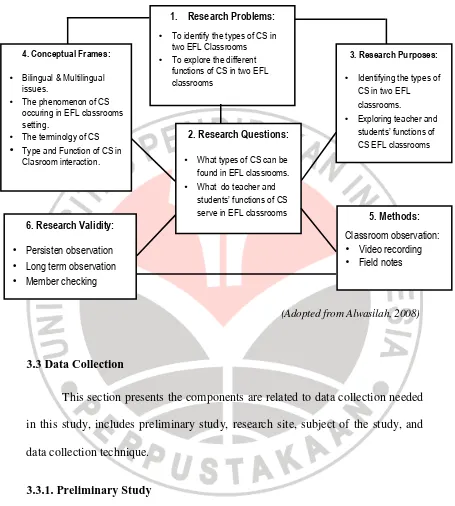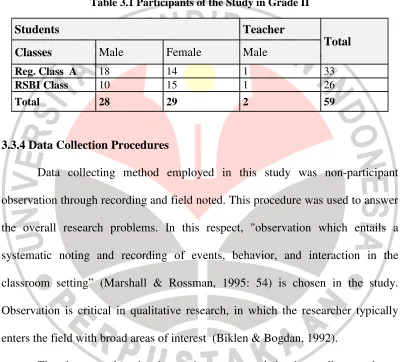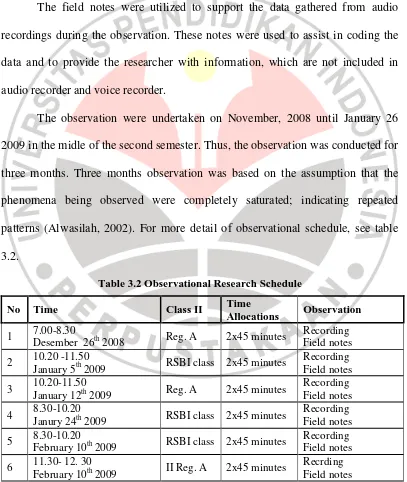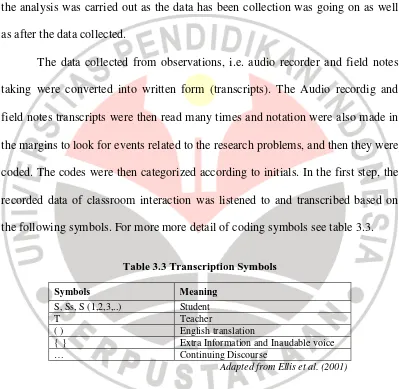1 CHAPTER III
RESEARCH METHODOLOGY
This chapter covers five sections: (3.1) Research problems aimed to be explored in this study, (3.2) Research Design (3.3) Data Collection Method which includes research site, subject of study, observation and field notes, (3.4) Data Analysis, and (3.5) Research Validity, which includes persistent, long term observation and member checking.
3.1 Research Problems
There are two questions posed to be investigates in this study. the questions are formulated as follow:
a) what types of code switching are found in EFL classrooms? b) what functions do teacher and student’s serve in EFL classrooms?
3.2 Research Design
This study utilizes a qualitativemethodology. The qualitativemethodology is chosen because it allows the researcher to capture naturally occurring interactions among the participants. In this case, this study attempts to see natural phenomena of classroom interaction. Detailed observations and descriptions of context and what people said or did formed the basis for inductive rather than deductive analysis. In this respect, a theory is used to explain the data, rather than data collected to test pre-established hypotheses (Locke and Silverman, 1993).
2 (1988: 21) defines a case study as “detailed examination of one setting or a single subject in a single depository of documents or one particular event”.
This study was designed to identify and describe the phenomena of CS in EFL clasrooms setting (Creswell, 1998) particularly, to identify and explore ; the types and the functions of CS in two EFL clasrooms (see Hanna, 2004; Merritt et al. 1992 and Canagarajah 1995).
To have clear picture on the relatonship among components in this present study, the interactive model of research design cetakbiru of Alwasilah (2008: 86) was adopted. The reason of adopting this model was to help clarify the overall outlines of the research.
3 Figure 3.1 Research Design of Code Switching Phenomenon in EFL Classrooms
reaction
(Adopted from Alwasilah, 2008)
3.3 Data Collection
This section presents the components are related to data collection needed in this study, includes preliminary study, research site, subject of the study, and data collection technique.
3.3.1. Preliminary Study
Two pilot studies were conducted prior to the real study. The first pilot study was conducted in a second grade Regular class of SMP in Mataram and in third grade of Regular class and RSBI class of SMP in Bandung. In those schools, the data needed in this study were significantly found during learning activities.
4 Before conducting the second pilot study, the researcher asked the teacher’s perception about the use of Indonesia (CS) in English class. at the time, the teacher in the second pilot study said that the use of Indonesian during the classrom lesson in English class was acceptable since the aims was to discover the student with multiple competence in understanding the lesson better.
3.3.2 Research Site
This study was undertaken at a Junior High School in Lembang. It was located in the city of Bandung West Java Province. Compared with the other schools, this school was the more popular in terms of its extra-lesson activities. The school, for example, runs extra-lesson activities which encouranges the teachers and students to use English. The school also made English as the school daily communication, both inside and outside the classroom. The school was choosen for the present study due to several reasons. First, the issue being investigated was dealing with the school’s program. Second, the school authorities allowed the researcher to conduct this research.
3.3.3 Subject of the Study
5 All of the students (participants) were originally Indonesian. The teachers involved in this study were an experienced English teachers who had been teaching English for more than ten years. Table 3.1 shows the depicts number of participant in the second grades.
Table 3.1 Participants of the Study in Grade II
Students Teacher
Data collecting method employed in this study was non-participant observation through recording and field noted. This procedure was used to answer the overall research problems. In this respect, "observation which entails a systematic noting and recording of events, behavior, and interaction in the classroom setting” (Marshall & Rossman, 1995: 54) is chosen in the study. Observation is critical in qualitative research, in which the researcher typically enters the field with broad areas of interest (Biklen & Bogdan, 1992).
6 interaction between the teacher and the students or among students.
Audio recorder commenced two weeks after the initial Regular and RSBI class visits to each classroom, once the researcher identified the subjects that were the focused of the research. There were totally 3 sessions collected in each classroom. Each session was approximately one and-a-half-hour long.
The field notes were utilized to support the data gathered from audio recordings during the observation. These notes were used to assist in coding the data and to provide the researcher with information, which are not included in audio recorder and voice recorder.
The observation were undertaken on November, 2008 until January 26 2009 in the midle of the second semester. Thus, the observation was conducted for three months. Three months observation was based on the assumption that the phenomena being observed were completely saturated; indicating repeated patterns (Alwasilah, 2002). For more detail of observational schedule, see table
January 5th 2009 RSBI class 2x45 minutes
Recording Field notes
3 10.20-11.50
January 12th 2009 Reg. A 2x45 minutes
Recording Field notes
4 8.30-10.20
Janury 24th 2009 RSBI class 2x45 minutes
Recording Field notes
5 8.30-10.20
February 10th 2009 RSBI class 2x45 minutes
Recording Field notes
6 11.30- 12. 30
February 10th 2009 II Reg. A 2x45 minutes
7 3.4 Data Analysis
The aim of the data analysis is to discover pattern, ideas, explanations, and understanding (McMillan, 1992: 221). He also argues that data anaysis of qualitative studies are interwoven, influencing each other; therefore, in this study the analysis was carried out as the data has been collection was going on as well as after the data collected.
The data collected from observations, i.e. audio recorder and field notes taking were converted into written form (transcripts). The Audio recordig and field notes transcripts were then read many times and notation were also made in the margins to look for events related to the research problems, and then they were coded. The codes were then categorized according to initials. In the first step, the recorded data of classroom interaction was listened to and transcribed based on the following symbols. For more more detail of coding symbols see table 3.3.
Table 3.3 Transcription Symbols
Symbols Meaning
S, Ss, S (1,2,3,..) Student
T Teacher
( ) English translation
{ } Extra Information and Inaudable voice
… Continuing Discourse
Adapted from Ellis et al. (2001)
8 Types of CS which derived from Poplack (1980) and Romaine (2001) were used to categorize which types they utilized. In order to find out which functions they served for, Canagarajah (1995) & Hanna’s (2005) frame work were applied. The closer analysis begun by explaining what happened in the situation, who initiated CS, how CS occured, and what function CS server for.
3.5 Research Validity
In qualitative method, validity refers to the “trustworthiness” (Erlandson et al., 1993 in Creswell, 1994: 157) of a study, or “how research findings match reality” (Merriam, 1998: 201), and “can be applied to other situations” (Merriam, 1998: 207). regarding the finding match the reality, design of the present study is qualitative, the discussion focuses only on how to promote validity in qualitative research.
To promote credibility, there are some of the techniques commonly used in a qualitative, i.e. triangulation, member checks, long-term observation, peer examination, participatory or collaborative modes of research, and researcher’s biases, thick description, typicality or modal category, and multisite designs (Merriam, 1998; Cresswell, 1998; see also Alwasilah, 2000: 170-185). Among other strategies mentioned, the present study uses the following techniques:
3.6.1 Persistent observation. Persistent observation means that gathering data at the research site without involving observer at the same time. In this case, the observations were conducted more than once to find out their patterns. 3.6.2 Long term-observation. In this study, the observation was initiated by
9 intended to identify whether the occurrences of CS significant to study. The formal observations were conducted after the focused of the research had been vividly determined, that is on January up to February 2009.



